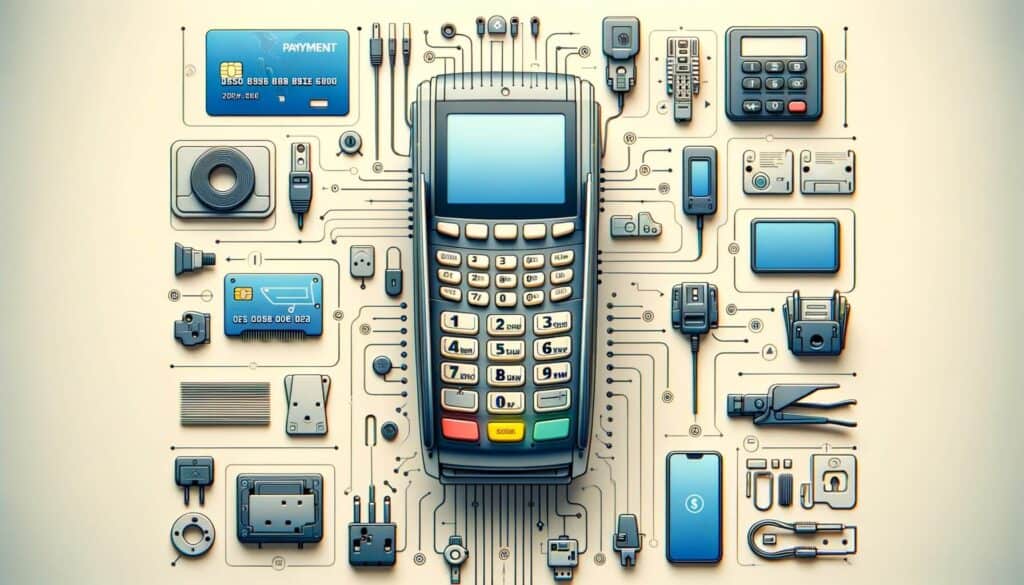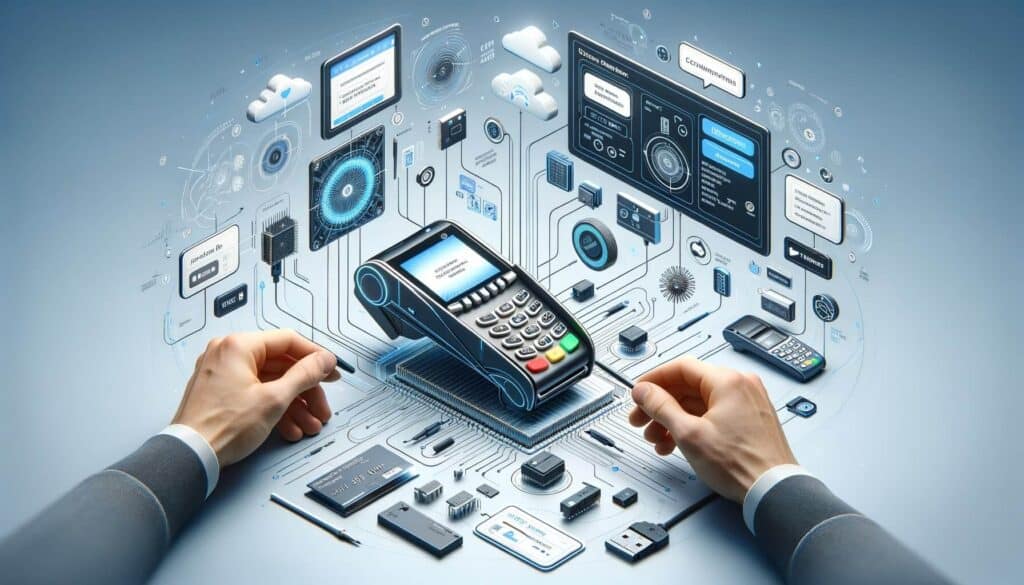
By Amanda Hoglund February 20, 2025
In today’s digital age, payment terminals have become an essential tool for businesses of all sizes. These devices enable merchants to accept various forms of payment, including credit and debit cards, mobile payments, and contactless transactions. Payment terminals serve as a gateway to modern transactions, providing convenience and security for both merchants and customers.
This comprehensive guide will walk you through the basics of payment terminals, from understanding the different types to choosing the right one for your business.
Understanding the Types of Payment Terminals: From Traditional to Modern

Payment terminals have evolved significantly over the years, transitioning from traditional countertop devices to modern, feature-rich solutions. Understanding the different types of payment terminals is crucial for selecting the one that best suits your business needs.
1. Traditional Countertop Terminals: These are the most common type of payment terminals found in retail stores and restaurants. They are typically connected to a landline or internet connection and require a physical card to be inserted or swiped.
2. Wireless Terminals: As the name suggests, wireless terminals operate without the need for a physical connection. They use cellular networks or Wi-Fi to process transactions, making them ideal for businesses that require mobility, such as food trucks or delivery services.
3. Mobile Payment Solutions: With the rise of smartphones, mobile payment solutions have gained popularity. These solutions utilize mobile apps and card readers that can be attached to smartphones or tablets, allowing businesses to accept payments on the go.
4. Contactless Payment Terminals: Contactless payment terminals enable customers to make payments by simply tapping their contactless-enabled cards or mobile devices on the terminal. This technology, known as Near Field Communication (NFC), provides a faster and more convenient payment experience.
Key Features and Functions of Payment Terminals: What to Look For

When choosing a payment terminal, it is essential to consider the key features and functions that will best serve your business. Here are some important factors to look for:
1. Compatibility: Ensure that the payment terminal is compatible with the payment methods you want to accept, such as credit and debit cards, mobile payments, and contactless transactions.
2. Security: Payment terminals should comply with the Payment Card Industry Data Security Standard (PCI DSS) to ensure the protection of sensitive customer data. Look for features like encryption and tokenization to safeguard transactions.
3. Connectivity: Depending on your business needs, consider the connectivity options available for the payment terminal. Options may include Ethernet, Wi-Fi, Bluetooth, or cellular networks.
4. User-Friendly Interface: A user-friendly interface is crucial for both merchants and customers. Look for terminals with intuitive menus, easy-to-read screens, and responsive touchscreens.
5. Reporting and Analytics: Some payment terminals offer reporting and analytics features that provide valuable insights into your business’s sales performance. These features can help you make informed decisions and optimize your operations.
How Payment Terminals Work: A Step-by-Step Guide
Payment terminals may seem complex, but understanding how they work can demystify the process. Here is a step-by-step guide to help you understand the inner workings of payment terminals:
1. Initiation: The payment process begins when a customer presents their payment card or mobile device to the payment terminal.
2. Card Reading: The payment terminal reads the card’s information by either inserting it into a chip reader, swiping it through a magnetic stripe reader, or tapping it on a contactless-enabled terminal.
3. Authorization: The payment terminal sends the card information to the payment processor or acquiring bank for authorization. The processor verifies the card’s validity and checks if the customer has sufficient funds.
4. Transaction Approval: If the authorization is successful, the payment processor sends an approval message back to the payment terminal. The terminal then displays a confirmation message to the customer.
5. Receipt Generation: After the transaction is approved, the payment terminal generates a receipt for the customer. This can be in the form of a printed receipt or a digital receipt sent via email or SMS.
Choosing the Right Payment Terminal for Your Business: Factors to Consider

Selecting the right payment terminal for your business is crucial for ensuring smooth transactions and customer satisfaction. Consider the following factors when making your decision:
1. Business Type: Different businesses have different payment needs. Consider whether you need a countertop terminal, a wireless solution, or a mobile payment option based on your business type and operations.
2. Payment Methods: Determine the payment methods you want to accept. Ensure that the payment terminal supports the necessary technologies, such as EMV chip cards, contactless payments, and mobile wallets.
3. Scalability: If you anticipate business growth, choose a payment terminal that can accommodate increased transaction volumes and additional features in the future.
4. Cost: Payment terminals come with various pricing models, including upfront costs, monthly fees, and transaction fees. Consider your budget and evaluate the total cost of ownership before making a decision.
5. Customer Experience: A seamless and convenient payment experience is essential for customer satisfaction. Look for payment terminals that offer fast transaction processing, contactless payment options, and easy-to-use interfaces.
Setting Up and Installing Your Payment Terminal: A Beginner’s Guide

Setting up and installing a payment terminal may seem daunting, but with the right guidance, it can be a straightforward process. Follow these steps to get your payment terminal up and running:
1. Unboxing: Carefully unpack the payment terminal and ensure that all the components are included. This typically includes the terminal itself, power cables, connectivity cables, and any additional accessories.
2. Power Connection: Connect the power cable to the payment terminal and plug it into a power outlet. Ensure that the terminal is receiving power and turned on.
3. Connectivity: Depending on the type of payment terminal, connect it to the appropriate network. This may involve connecting to an Ethernet port, Wi-Fi network, or cellular network.
4. Software Setup: Follow the manufacturer’s instructions to install any necessary software or firmware updates on the payment terminal. This ensures that you have the latest features and security patches.
5. Merchant Account Setup: If you haven’t already done so, set up a merchant account with a payment processor or acquiring bank. This account will enable you to accept payments and receive funds.
Ensuring Payment Security: Best Practices for Payment Terminals
Payment security is of utmost importance when it comes to handling customer transactions. Implementing best practices for payment terminals can help protect sensitive customer data and prevent fraud. Here are some key security measures to consider:
1. PCI DSS Compliance: Ensure that your payment terminal is compliant with the Payment Card Industry Data Security Standard (PCI DSS). This standard outlines security requirements for handling cardholder data and preventing data breaches.
2. Encryption: Look for payment terminals that support end-to-end encryption. This technology encrypts cardholder data from the moment it is captured at the terminal until it reaches the payment processor, making it unreadable to unauthorized parties.
3. Tokenization: Tokenization replaces sensitive cardholder data with unique tokens. These tokens are used for transaction processing, while the actual card data is securely stored by the payment processor. Tokenization adds an extra layer of security by minimizing the risk of data theft.
4. Regular Updates: Keep your payment terminal’s software and firmware up to date. Manufacturers often release updates that address security vulnerabilities and improve overall performance.
5. Employee Training: Educate your employees on best practices for handling payment terminals and customer data. Train them to identify and report any suspicious activity or signs of tampering.
Troubleshooting Common Issues with Payment Terminals: Tips and Tricks
Despite their reliability, payment terminals can occasionally encounter issues that disrupt the payment process. Knowing how to troubleshoot common problems can save time and frustration. Here are some tips and tricks for resolving common payment terminal issues:
1. Connectivity Issues: If your payment terminal is not connecting to the network, ensure that the cables are securely connected and that you have a stable internet connection. Restarting the terminal or resetting the network settings may also help.
2. Card Reading Problems: If the payment terminal is having trouble reading cards, check for any dirt or debris on the card reader. Gently clean the reader with a soft cloth or use compressed air to remove any particles.
3. Error Messages: Pay attention to any error messages displayed on the payment terminal. These messages often provide valuable information about the issue at hand. Consult the terminal’s user manual or contact technical support for assistance.
4. Power Issues: If your payment terminal is not turning on or is experiencing power-related problems, check the power cable and outlet for any issues. Try using a different power outlet or replacing the power cable if necessary.
5. Software Updates: Regularly check for software updates for your payment terminal. Installing the latest updates can resolve software-related issues and improve overall performance.
Frequently Asked Questions (FAQs) about Payment Terminals: Answered
Q1. What is the average cost of a payment terminal?
Answer: The cost of a payment terminal can vary depending on the type, features, and brand. Traditional countertop terminals typically range from $100 to $500, while wireless or mobile solutions can range from $200 to $800. Additional costs may include monthly fees, transaction fees, and software licensing fees.
Q2. Can payment terminals accept all types of payment methods?
Answer: Payment terminals can accept various payment methods, including credit and debit cards, mobile payments, and contactless transactions. However, it is essential to ensure that the terminal you choose supports the specific payment methods you want to accept.
Q3. How long does it take for a payment to be processed?
Answer: The time it takes for a payment to be processed can vary depending on several factors, including the payment method, network connectivity, and the payment processor’s response time. In general, most transactions are processed within a few seconds.
Q4. Are payment terminals secure?
Answer: Payment terminals are designed with security in mind and must comply with the Payment Card Industry Data Security Standard (PCI DSS). However, it is crucial to implement additional security measures, such as encryption and tokenization, to further protect customer data.
Q5. Can payment terminals be used offline?
Answer: Some payment terminals have offline capabilities, allowing them to process transactions even when there is no internet connection. These terminals store transaction data securely and transmit it for processing once a connection is restored.
Conclusion
Payment terminals have revolutionized the way businesses accept payments, providing convenience, security, and flexibility. Understanding the different types of payment terminals, their key features and functions, and how they work is essential for selecting the right solution for your business.
By following best practices for payment security, troubleshooting common issues, and considering factors such as compatibility and scalability, you can ensure a seamless payment experience for your customers. Embrace the power of payment terminals and unlock the potential for growth and success in the modern world of transactions.